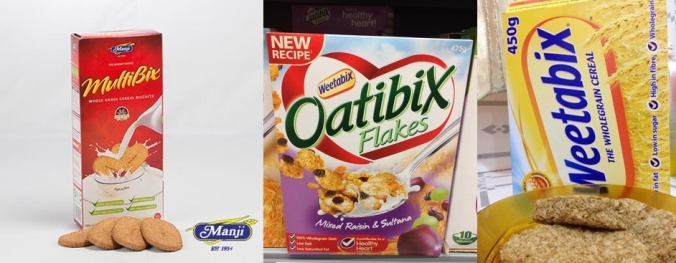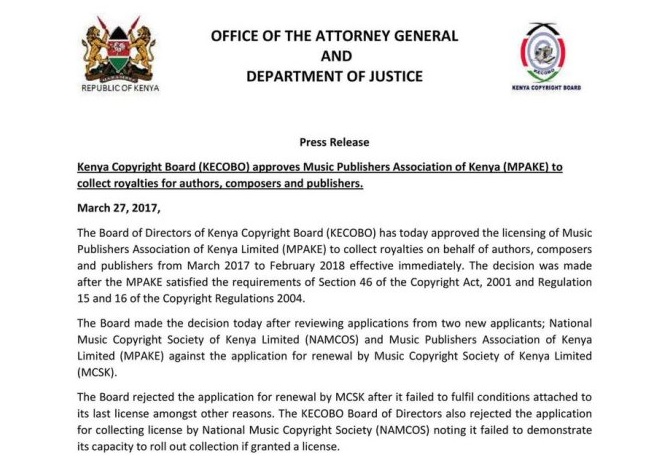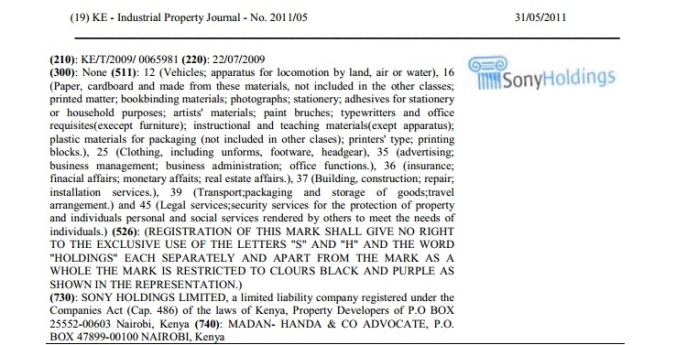
Recent media reports indicate that United Kingdom-based cereals maker Weetabix Limited has asked the High Court to bar a Kenyan company Manji Food Industries from marketing one of its products—Multibix—arguing that the name infringes on its rights under the law of trade marks and as a result Weetabix has suffered or will suffer loss and damage.
In the suit papers filed at the High Court, Weetabix has reportedly contended that: “Manji Food Industries has put up on the Kenyan market whole grain biscuits not of Weetabix’s manufacture bearing the name Multibix, that is a deceptive imitation of the well-known products of the plaintiff namely Weetabix and Oatibix”
In reply, it reported that Manji has denied the allegations by Weetabix, arguing that the Multibix brand is not intended to confuse consumers of Weetabix’s products and that it is an independent brand with its own following.
The Kenyan cereals manufacturer reportedly contended in its replying affidavit that:
“Manji admits that it manufactures, packs and distributes its product known as Multibix, but denies that it does the same deceptively to imitate Weetabix’s products. Manji denies that it is passing off its product as that of Weetabix or that it has led to confusion”
As many readers may be aware, Weetabix successfully opposed an attempt by Manji to register ‘Multibix’ as a trademark. A copy of the ruling by the Registrar of Trademarks in this matter is available here.
Despite this ruling, it is reported that Manji has continued marketing its product using the Multibix name which Weetabix argues infringes on its well-known trademarks, Weetabix and Oatibix. In this connection, Manji contends that it had lodged an intended appeal against the decision of the Registrar in the opposition proceedings. In reply, Weetabix reportedly asserted that “An intended appeal is not an appeal. An appeal is not in any way a stay of the decision of the registrar and therefore this decision is unchallenged”.
In light of the above, this blogpost revisits some of the salient findings of the Registrar’s ruling in a bid to provide necessary context for Manji’s appeal and Weetabix’s current suit against Manji.
The facts of In Re TMA No. 66428 “MULTIBIX”, Opposition by Weetabix Ltd, 31 August 2012 are briefly that Manji Food Industries Limited lodged an application for registration of trade mark KE/T/2009/066428 “MULTIBIX” (a word mark). The mark was applied for in class 30 in respect of “biscuits”. The Registrar of Trade Marks duly examined the mark in accordance with the provisions of the Trade Marks Act Cap 506 of the Laws of Kenya and the mark was approved and published in the Industrial Property Journal on 30th April 2010 on page 20.
Thereafter, Weetabix Limited filed a Notice of Opposition against registration of the mark. According to the registrar, there were two issues for determination, namely:
1. Is Manji’s mark “MULTIBIX” so similar to the Weetabix’s mark “Weetabix” as to cause a likelihood of confusion in contravention of the provisions of section 14 of the Trade Marks Act?
2. Is Weetabix’s mark “WEETABIX” a well-known mark in Kenya and therefore deserving of protection under section 15A of the Trade Marks Act?
Regarding the first issue, the Registrar relies on the test set out in the American case of Eli Lily & Co v Natural Answers Inc 233, F. 3d 456 to determine whether or not marks are similar. In that case, some of the factors to consider include:
(a) The strength of the complainant’s mark;
(b) Similarity between the marks in appearance and suggestion;
(c) The degree of care likely to be exercised by consumers; and
(d) The area and manner of concurrent use of the products.
On the claim of similarity between the marks in appearance, the Registrar makes the following finding:
“The common element between the two marks “WEETABIX” and “MULTIBIX” is the suffix “BIX” which is also a registered mark of the Opponents. The term “BIX” is not an English word and is a creation of the Opponents, which I had earlier indicated that it is a strong mark. The Applicants’ mark is comprised of the word “MULTI” and the said suffix “BIX”. I am therefore of the view that the two marks are similar in appearance.”
In determining the first issue of the opposition proceedings, the Registrar states:
“I disagree with the Applicants when they state that the respective goods of the Opponents and the Applicants are different. It is my view that the goods in respect of which the Opponents have registered their aforementioned marks are goods of the same description as the goods in respect of which the Applicants are seeking to register their mark “MULTIBIX”. This means that both the goods of the Applicants and the Opponents would be sold in the same trade channels thus enhancing the likelihood of confusion or deception. It has long been held that the closer the relationship between particular goods, the more likely any similarity in their respective trade marks would prove deceptive. For this reason, and having held that the marks are similar, then it follows that registration of the Applicants’ mark “MULTIBIX” would be against the provisions of the Trade Marks Act.
Having considered all the relevant factors in regard to similarity of the marks and having considered the two word marks and all the circumstances of these opposition proceedings as stated by Parker J in the aforementioned Pianotist’s Application, I have come to the conclusion that the two marks “WEEETABIX” and “MULTIBIX” are similar and that entry of both marks in the Register of Trade Marks would be a contravention of the provisions of sections 14 and 15(1) of the Trade Marks Act.”
The second and final issue for determination by Registrar was whether “WEETABIX” is a well-known mark in Kenya and therefore deserving protection under the provisions of section 15A of the Act. The Registrar relies on the test for well-known marks set out in the UK case referred to as Oasis Ltd’s Trade Mark Application, where the Court set out the factors to consider namely:
(1) the inherent distinctiveness of the earlier trade mark;
(2) the extent of the reputation that the earlier mark enjoys;
(3) the uniqueness or otherwise of the mark in the market place;
(4) the range of goods or services for which the earlier mark enjoys reputation; and
(5) whether or not the earlier trade mark will be any less distinctive for the goods or services for which it has a reputation than it was before.
In applying the above case, the Registrar arrives at the following finding:
“I am of the view that the Applicants have submitted adequate evidence to indicate that the mark “WEETABIX” has gained such a reputation in the Kenyan market for the mark to be considered well known in Kenya. The said reputation has been gained through promotion and marketing of the said mark on the various media in Kenya and the trade mark “WEETABIX” has come to be only associated with the goods offered for sale by the Opponents.
(….)
In the aforementioned statutory declaration sworn by Richard Martin and filed on behalf of the Opponents, it is indicated that the Opponents’ mark “WEETABIX” together with the aforementioned variants has been registered in numerous jurisdictions of the world. The Opponents have also attached a number of certificates to indicate that their said mark is registered and subsisting in the Register of Trade Marks in the respective jurisdictions. Further, there is an indication as to the various countries where the Applicants’ goods bearing the mark “WEETABIX” have been marketed. In Kenya, the trade mark “WEETABIX” was entered in the Register of Trade Marks with effect from 28th June 1954. This means that the said mark “WEETABIX” has been in the Register of Trade Marks in Kenya for the last fifty-eight (58) years. Further, records at the Registry of Trade Marks indicate that the Opponents have registered several other marks that comprise the suffix “BIX” and which are still subsisting in the Register of Trade Marks.
Further, and as earlier indicated, the mark has been used in the Kenyan market for over thirty (30) years now. In my view, the above-mentioned registrations and use in several jurisdictions including Kenya indicate that the mark is well known. In conclusion and after considering all the relevant factors, it is my opinion that the mark “WEETABIX” is quite well known in Kenya and deserves protection under the provisions of section 15A of the Trade Marks Act.”
As a result, the Registrar found that Weetabix was successful in its opposition of Manji’s application therefore the MULTIBIX application would not proceed to registration. The Registrar also awarded the costs of the opposition proceedings to Weetabix.
With this background in mind, this blogger will be keenly following the developments in the dispute before the High Court.







